Business Finance Report: MDL Cashflow and Budgeting Strategies
VerifiedAdded on 2023/01/11
|13
|3465
|63
Report
AI Summary
This report provides a detailed overview of fundamental financial concepts, including profit, cash flow, and working capital, as well as the impact of changes in working capital on cash flow. It analyzes the financial situation of a company, MDL, and suggests strategies to improve its working capital and cash flow position. The report also explores the purpose and different types of budgeting methods, such as traditional and zero-based budgeting, and evaluates their applicability for future cost management, recommending the most appropriate method for Second Sight Plc's business expansion plan. The report includes an executive summary, table of contents, and references.
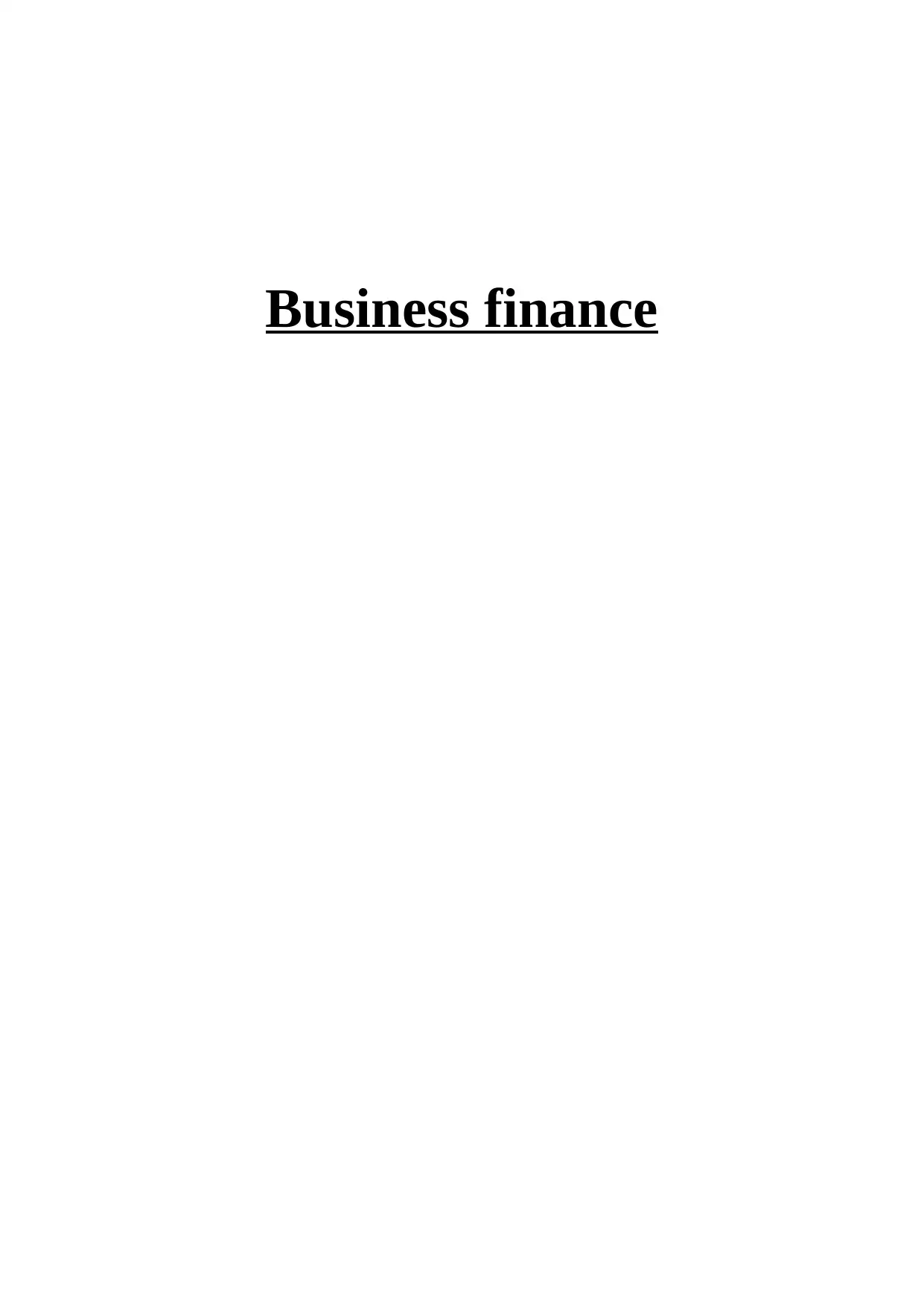
Business finance
Paraphrase This Document
Need a fresh take? Get an instant paraphrase of this document with our AI Paraphraser
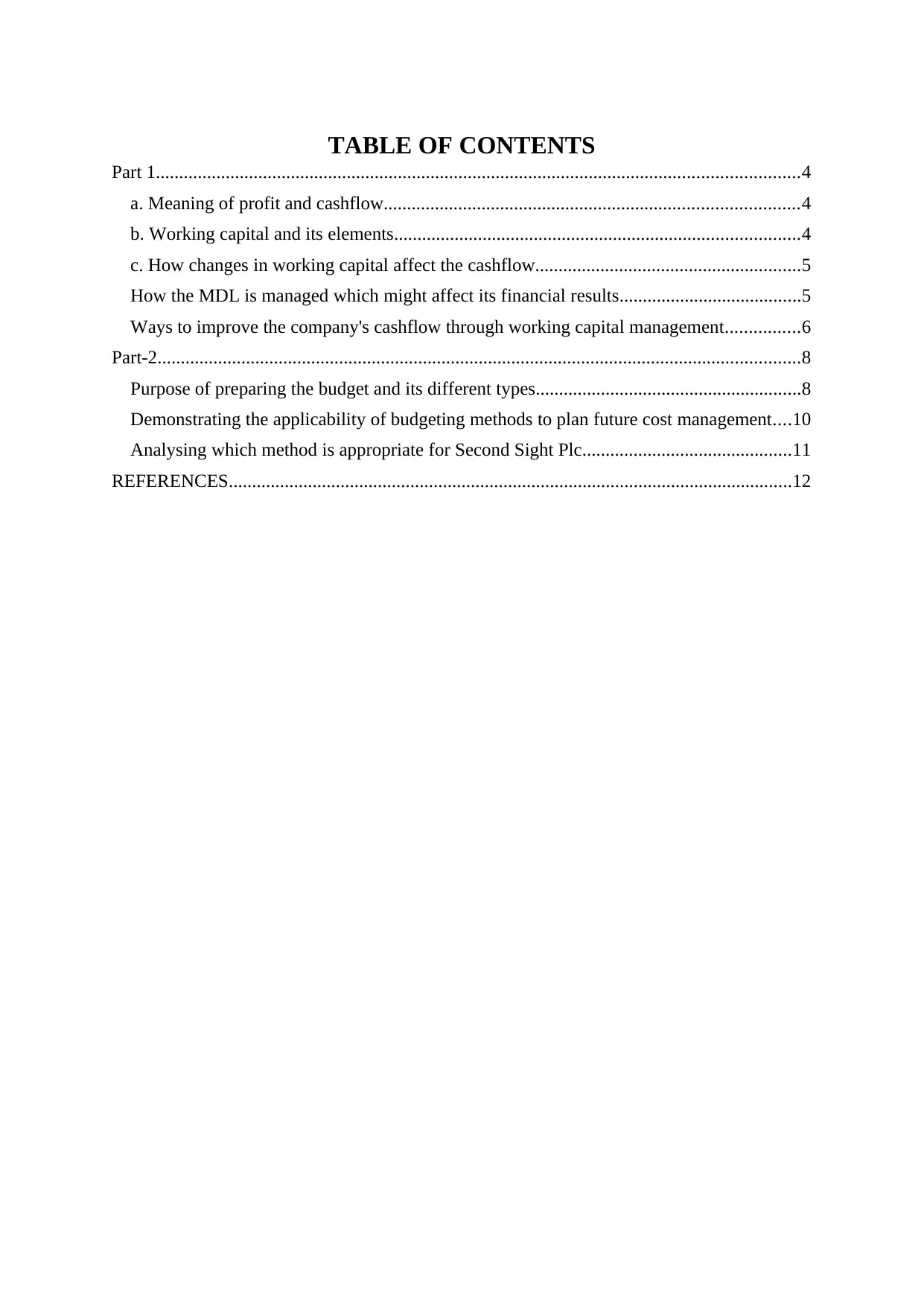
TABLE OF CONTENTS
Part 1..........................................................................................................................................4
a. Meaning of profit and cashflow.........................................................................................4
b. Working capital and its elements.......................................................................................4
c. How changes in working capital affect the cashflow.........................................................5
How the MDL is managed which might affect its financial results.......................................5
Ways to improve the company's cashflow through working capital management................6
Part-2..........................................................................................................................................8
Purpose of preparing the budget and its different types.........................................................8
Demonstrating the applicability of budgeting methods to plan future cost management....10
Analysing which method is appropriate for Second Sight Plc.............................................11
REFERENCES.........................................................................................................................12
Part 1..........................................................................................................................................4
a. Meaning of profit and cashflow.........................................................................................4
b. Working capital and its elements.......................................................................................4
c. How changes in working capital affect the cashflow.........................................................5
How the MDL is managed which might affect its financial results.......................................5
Ways to improve the company's cashflow through working capital management................6
Part-2..........................................................................................................................................8
Purpose of preparing the budget and its different types.........................................................8
Demonstrating the applicability of budgeting methods to plan future cost management....10
Analysing which method is appropriate for Second Sight Plc.............................................11
REFERENCES.........................................................................................................................12
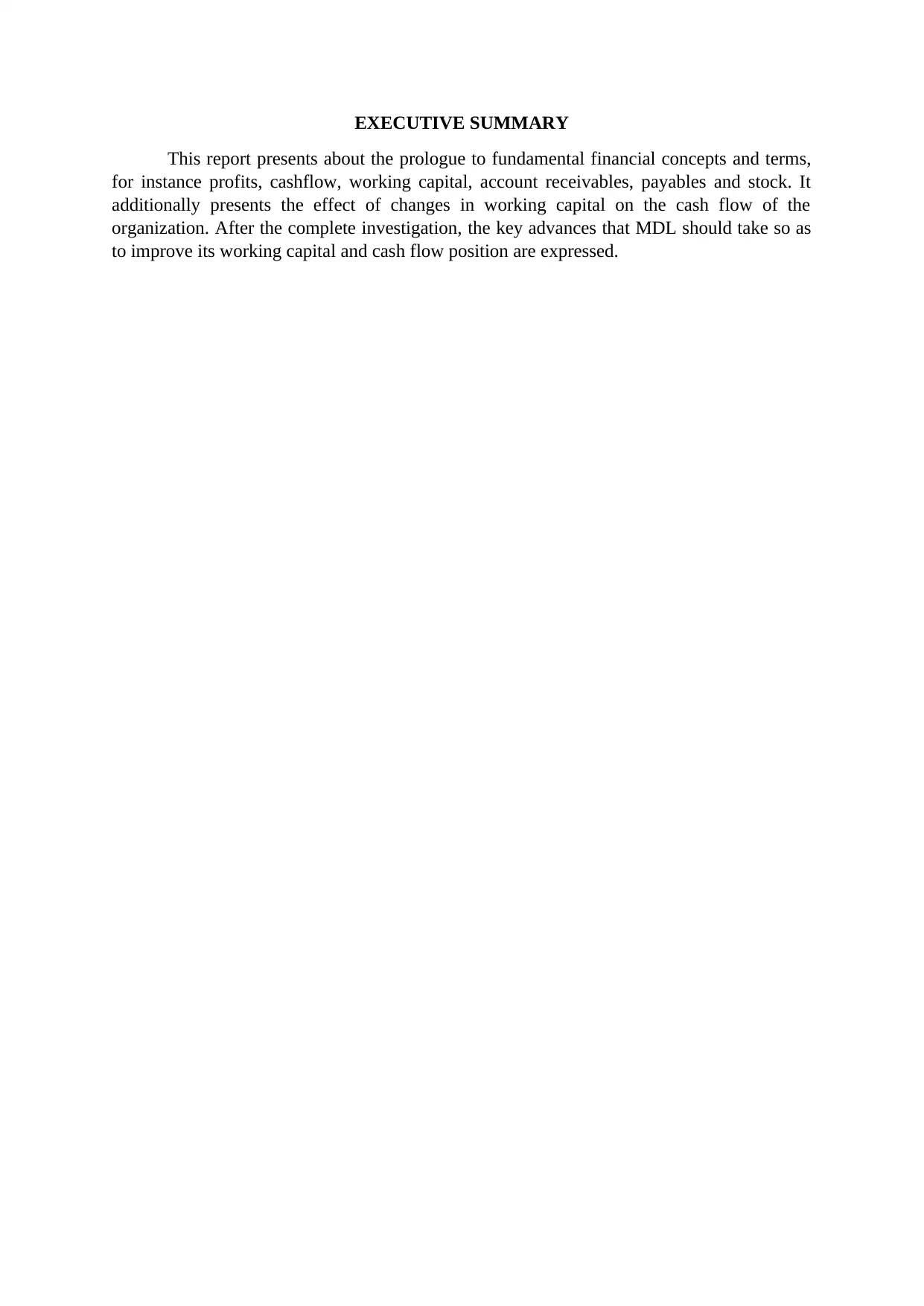
EXECUTIVE SUMMARY
This report presents about the prologue to fundamental financial concepts and terms,
for instance profits, cashflow, working capital, account receivables, payables and stock. It
additionally presents the effect of changes in working capital on the cash flow of the
organization. After the complete investigation, the key advances that MDL should take so as
to improve its working capital and cash flow position are expressed.
This report presents about the prologue to fundamental financial concepts and terms,
for instance profits, cashflow, working capital, account receivables, payables and stock. It
additionally presents the effect of changes in working capital on the cash flow of the
organization. After the complete investigation, the key advances that MDL should take so as
to improve its working capital and cash flow position are expressed.
⊘ This is a preview!⊘
Do you want full access?
Subscribe today to unlock all pages.

Trusted by 1+ million students worldwide
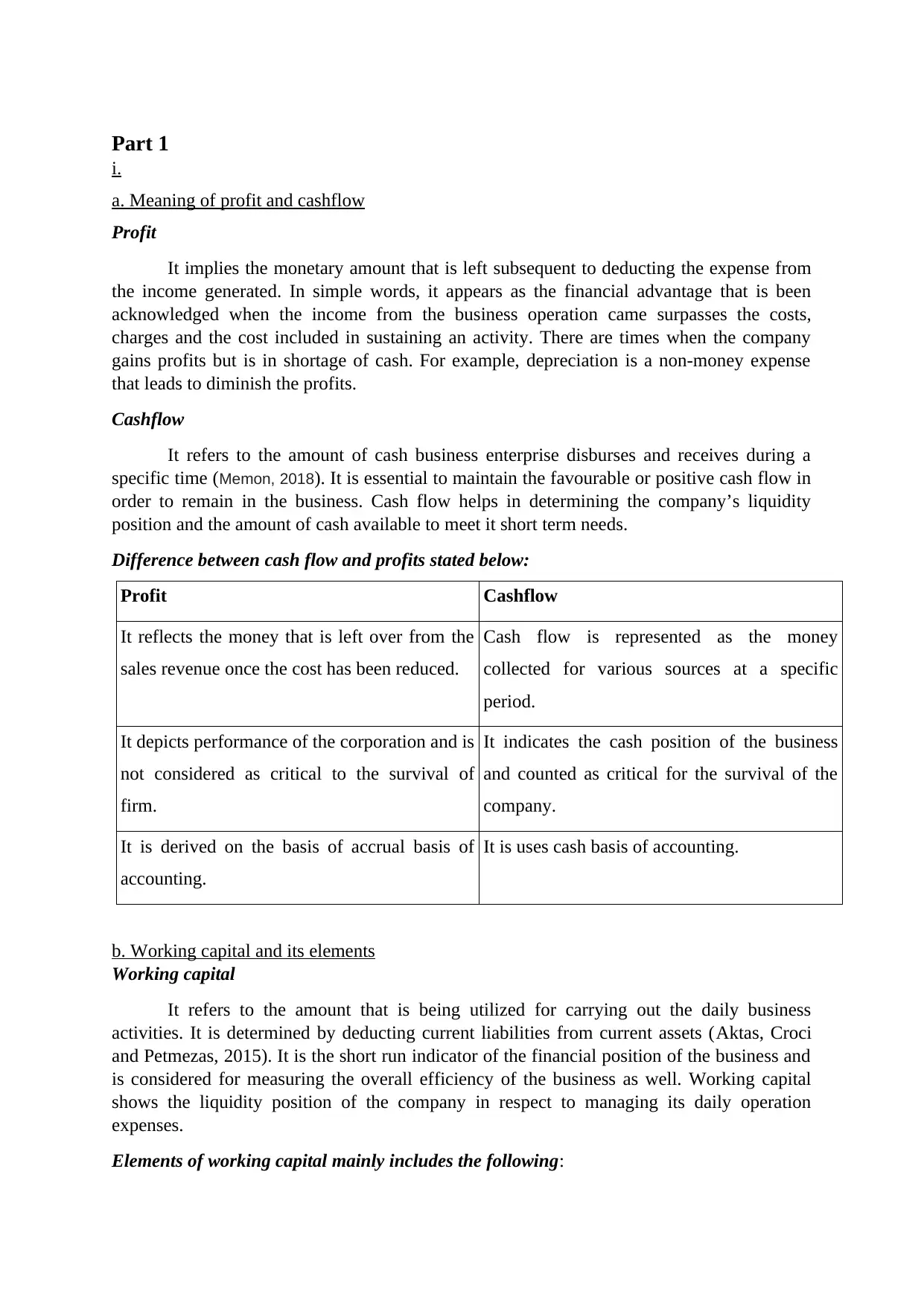
Part 1
i.
a. Meaning of profit and cashflow
Profit
It implies the monetary amount that is left subsequent to deducting the expense from
the income generated. In simple words, it appears as the financial advantage that is been
acknowledged when the income from the business operation came surpasses the costs,
charges and the cost included in sustaining an activity. There are times when the company
gains profits but is in shortage of cash. For example, depreciation is a non-money expense
that leads to diminish the profits.
Cashflow
It refers to the amount of cash business enterprise disburses and receives during a
specific time (Memon, 2018). It is essential to maintain the favourable or positive cash flow in
order to remain in the business. Cash flow helps in determining the company’s liquidity
position and the amount of cash available to meet it short term needs.
Difference between cash flow and profits stated below:
Profit Cashflow
It reflects the money that is left over from the
sales revenue once the cost has been reduced.
Cash flow is represented as the money
collected for various sources at a specific
period.
It depicts performance of the corporation and is
not considered as critical to the survival of
firm.
It indicates the cash position of the business
and counted as critical for the survival of the
company.
It is derived on the basis of accrual basis of
accounting.
It is uses cash basis of accounting.
b. Working capital and its elements
Working capital
It refers to the amount that is being utilized for carrying out the daily business
activities. It is determined by deducting current liabilities from current assets (Aktas, Croci
and Petmezas, 2015). It is the short run indicator of the financial position of the business and
is considered for measuring the overall efficiency of the business as well. Working capital
shows the liquidity position of the company in respect to managing its daily operation
expenses.
Elements of working capital mainly includes the following:
i.
a. Meaning of profit and cashflow
Profit
It implies the monetary amount that is left subsequent to deducting the expense from
the income generated. In simple words, it appears as the financial advantage that is been
acknowledged when the income from the business operation came surpasses the costs,
charges and the cost included in sustaining an activity. There are times when the company
gains profits but is in shortage of cash. For example, depreciation is a non-money expense
that leads to diminish the profits.
Cashflow
It refers to the amount of cash business enterprise disburses and receives during a
specific time (Memon, 2018). It is essential to maintain the favourable or positive cash flow in
order to remain in the business. Cash flow helps in determining the company’s liquidity
position and the amount of cash available to meet it short term needs.
Difference between cash flow and profits stated below:
Profit Cashflow
It reflects the money that is left over from the
sales revenue once the cost has been reduced.
Cash flow is represented as the money
collected for various sources at a specific
period.
It depicts performance of the corporation and is
not considered as critical to the survival of
firm.
It indicates the cash position of the business
and counted as critical for the survival of the
company.
It is derived on the basis of accrual basis of
accounting.
It is uses cash basis of accounting.
b. Working capital and its elements
Working capital
It refers to the amount that is being utilized for carrying out the daily business
activities. It is determined by deducting current liabilities from current assets (Aktas, Croci
and Petmezas, 2015). It is the short run indicator of the financial position of the business and
is considered for measuring the overall efficiency of the business as well. Working capital
shows the liquidity position of the company in respect to managing its daily operation
expenses.
Elements of working capital mainly includes the following:
Paraphrase This Document
Need a fresh take? Get an instant paraphrase of this document with our AI Paraphraser
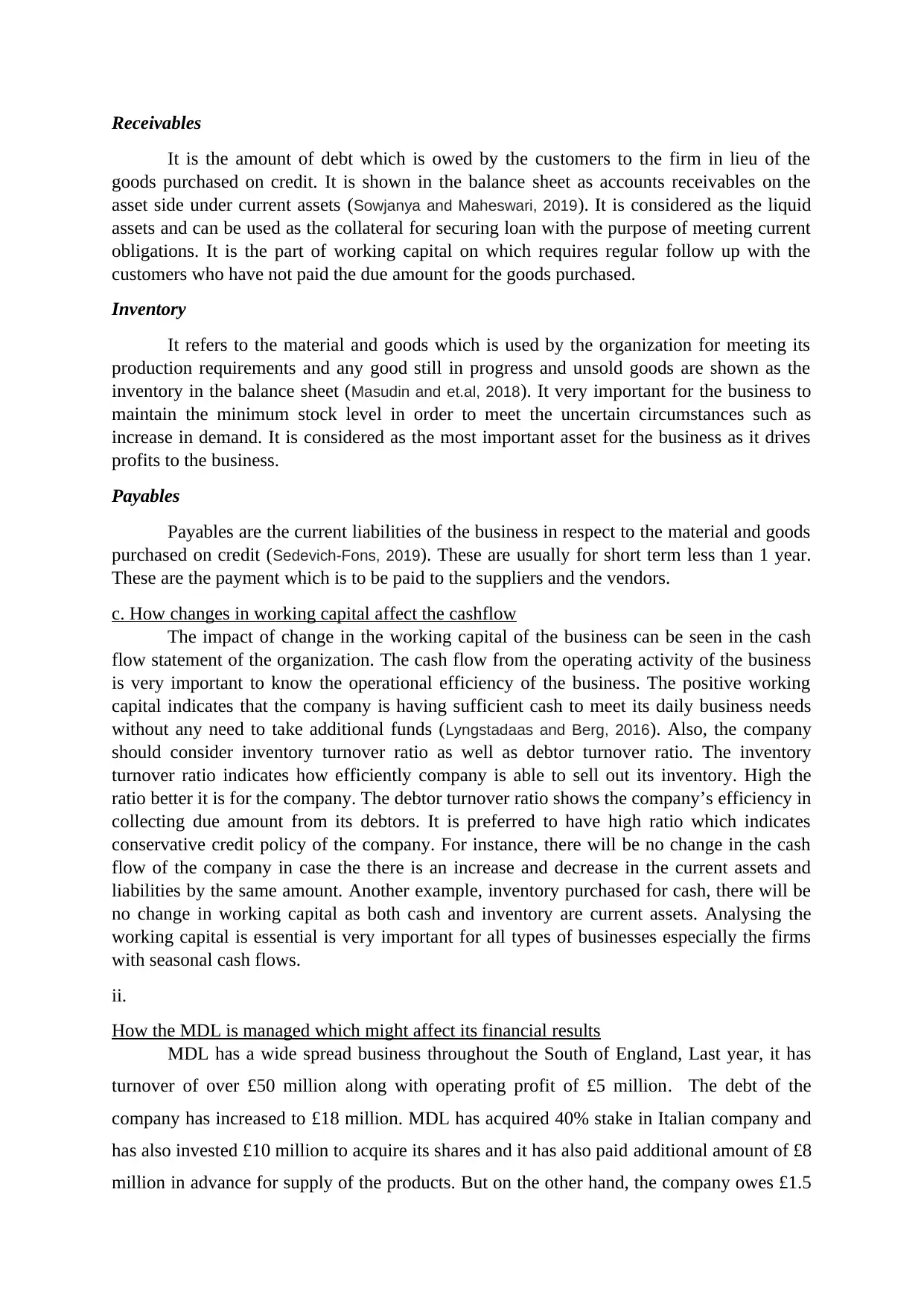
Receivables
It is the amount of debt which is owed by the customers to the firm in lieu of the
goods purchased on credit. It is shown in the balance sheet as accounts receivables on the
asset side under current assets (Sowjanya and Maheswari, 2019). It is considered as the liquid
assets and can be used as the collateral for securing loan with the purpose of meeting current
obligations. It is the part of working capital on which requires regular follow up with the
customers who have not paid the due amount for the goods purchased.
Inventory
It refers to the material and goods which is used by the organization for meeting its
production requirements and any good still in progress and unsold goods are shown as the
inventory in the balance sheet (Masudin and et.al, 2018). It very important for the business to
maintain the minimum stock level in order to meet the uncertain circumstances such as
increase in demand. It is considered as the most important asset for the business as it drives
profits to the business.
Payables
Payables are the current liabilities of the business in respect to the material and goods
purchased on credit (Sedevich-Fons, 2019). These are usually for short term less than 1 year.
These are the payment which is to be paid to the suppliers and the vendors.
c. How changes in working capital affect the cashflow
The impact of change in the working capital of the business can be seen in the cash
flow statement of the organization. The cash flow from the operating activity of the business
is very important to know the operational efficiency of the business. The positive working
capital indicates that the company is having sufficient cash to meet its daily business needs
without any need to take additional funds (Lyngstadaas and Berg, 2016). Also, the company
should consider inventory turnover ratio as well as debtor turnover ratio. The inventory
turnover ratio indicates how efficiently company is able to sell out its inventory. High the
ratio better it is for the company. The debtor turnover ratio shows the company’s efficiency in
collecting due amount from its debtors. It is preferred to have high ratio which indicates
conservative credit policy of the company. For instance, there will be no change in the cash
flow of the company in case the there is an increase and decrease in the current assets and
liabilities by the same amount. Another example, inventory purchased for cash, there will be
no change in working capital as both cash and inventory are current assets. Analysing the
working capital is essential is very important for all types of businesses especially the firms
with seasonal cash flows.
ii.
How the MDL is managed which might affect its financial results
MDL has a wide spread business throughout the South of England, Last year, it has
turnover of over £50 million along with operating profit of £5 million. The debt of the
company has increased to £18 million. MDL has acquired 40% stake in Italian company and
has also invested £10 million to acquire its shares and it has also paid additional amount of £8
million in advance for supply of the products. But on the other hand, the company owes £1.5
It is the amount of debt which is owed by the customers to the firm in lieu of the
goods purchased on credit. It is shown in the balance sheet as accounts receivables on the
asset side under current assets (Sowjanya and Maheswari, 2019). It is considered as the liquid
assets and can be used as the collateral for securing loan with the purpose of meeting current
obligations. It is the part of working capital on which requires regular follow up with the
customers who have not paid the due amount for the goods purchased.
Inventory
It refers to the material and goods which is used by the organization for meeting its
production requirements and any good still in progress and unsold goods are shown as the
inventory in the balance sheet (Masudin and et.al, 2018). It very important for the business to
maintain the minimum stock level in order to meet the uncertain circumstances such as
increase in demand. It is considered as the most important asset for the business as it drives
profits to the business.
Payables
Payables are the current liabilities of the business in respect to the material and goods
purchased on credit (Sedevich-Fons, 2019). These are usually for short term less than 1 year.
These are the payment which is to be paid to the suppliers and the vendors.
c. How changes in working capital affect the cashflow
The impact of change in the working capital of the business can be seen in the cash
flow statement of the organization. The cash flow from the operating activity of the business
is very important to know the operational efficiency of the business. The positive working
capital indicates that the company is having sufficient cash to meet its daily business needs
without any need to take additional funds (Lyngstadaas and Berg, 2016). Also, the company
should consider inventory turnover ratio as well as debtor turnover ratio. The inventory
turnover ratio indicates how efficiently company is able to sell out its inventory. High the
ratio better it is for the company. The debtor turnover ratio shows the company’s efficiency in
collecting due amount from its debtors. It is preferred to have high ratio which indicates
conservative credit policy of the company. For instance, there will be no change in the cash
flow of the company in case the there is an increase and decrease in the current assets and
liabilities by the same amount. Another example, inventory purchased for cash, there will be
no change in working capital as both cash and inventory are current assets. Analysing the
working capital is essential is very important for all types of businesses especially the firms
with seasonal cash flows.
ii.
How the MDL is managed which might affect its financial results
MDL has a wide spread business throughout the South of England, Last year, it has
turnover of over £50 million along with operating profit of £5 million. The debt of the
company has increased to £18 million. MDL has acquired 40% stake in Italian company and
has also invested £10 million to acquire its shares and it has also paid additional amount of £8
million in advance for supply of the products. But on the other hand, the company owes £1.5
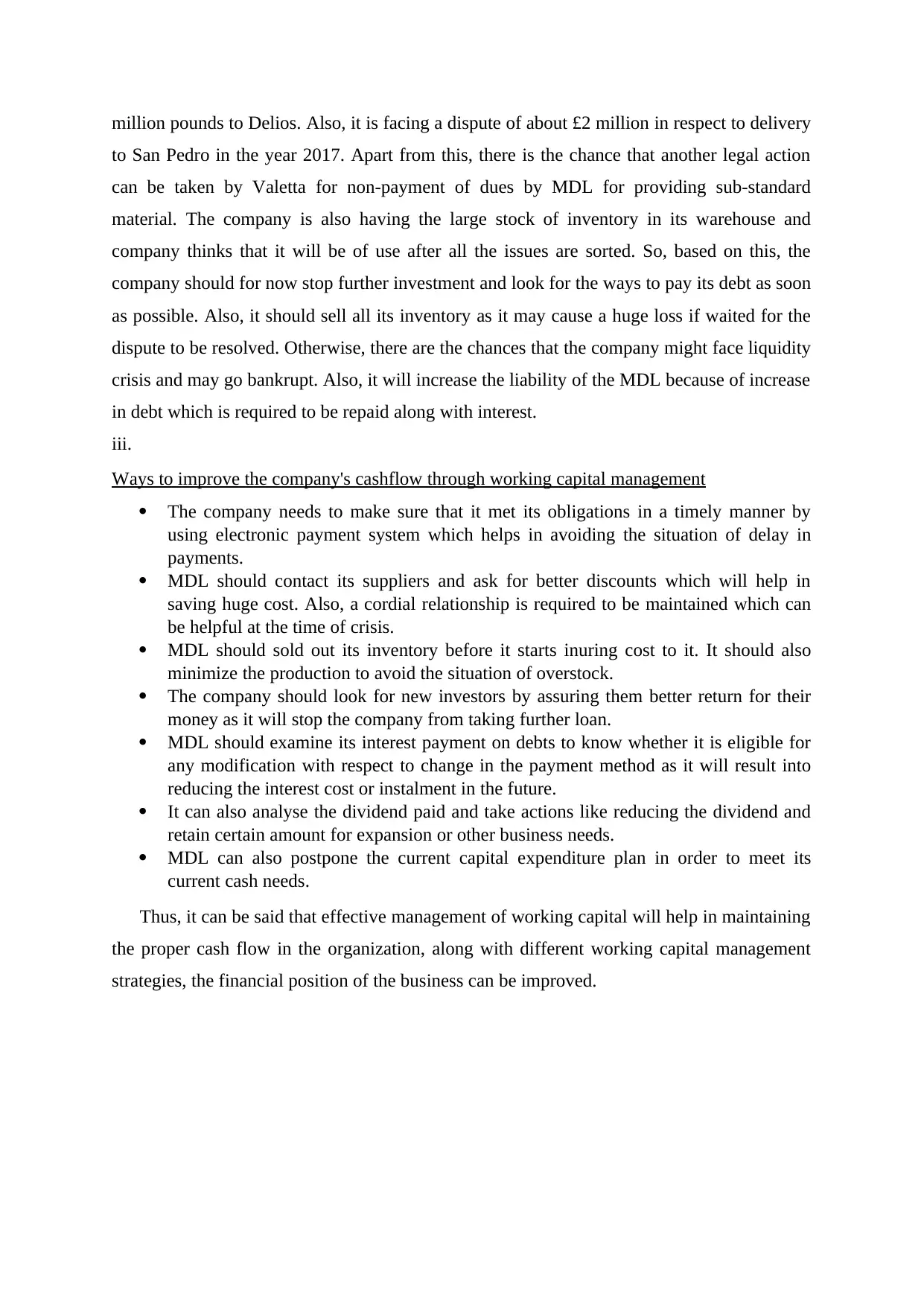
million pounds to Delios. Also, it is facing a dispute of about £2 million in respect to delivery
to San Pedro in the year 2017. Apart from this, there is the chance that another legal action
can be taken by Valetta for non-payment of dues by MDL for providing sub-standard
material. The company is also having the large stock of inventory in its warehouse and
company thinks that it will be of use after all the issues are sorted. So, based on this, the
company should for now stop further investment and look for the ways to pay its debt as soon
as possible. Also, it should sell all its inventory as it may cause a huge loss if waited for the
dispute to be resolved. Otherwise, there are the chances that the company might face liquidity
crisis and may go bankrupt. Also, it will increase the liability of the MDL because of increase
in debt which is required to be repaid along with interest.
iii.
Ways to improve the company's cashflow through working capital management
The company needs to make sure that it met its obligations in a timely manner by
using electronic payment system which helps in avoiding the situation of delay in
payments.
MDL should contact its suppliers and ask for better discounts which will help in
saving huge cost. Also, a cordial relationship is required to be maintained which can
be helpful at the time of crisis.
MDL should sold out its inventory before it starts inuring cost to it. It should also
minimize the production to avoid the situation of overstock.
The company should look for new investors by assuring them better return for their
money as it will stop the company from taking further loan.
MDL should examine its interest payment on debts to know whether it is eligible for
any modification with respect to change in the payment method as it will result into
reducing the interest cost or instalment in the future.
It can also analyse the dividend paid and take actions like reducing the dividend and
retain certain amount for expansion or other business needs.
MDL can also postpone the current capital expenditure plan in order to meet its
current cash needs.
Thus, it can be said that effective management of working capital will help in maintaining
the proper cash flow in the organization, along with different working capital management
strategies, the financial position of the business can be improved.
to San Pedro in the year 2017. Apart from this, there is the chance that another legal action
can be taken by Valetta for non-payment of dues by MDL for providing sub-standard
material. The company is also having the large stock of inventory in its warehouse and
company thinks that it will be of use after all the issues are sorted. So, based on this, the
company should for now stop further investment and look for the ways to pay its debt as soon
as possible. Also, it should sell all its inventory as it may cause a huge loss if waited for the
dispute to be resolved. Otherwise, there are the chances that the company might face liquidity
crisis and may go bankrupt. Also, it will increase the liability of the MDL because of increase
in debt which is required to be repaid along with interest.
iii.
Ways to improve the company's cashflow through working capital management
The company needs to make sure that it met its obligations in a timely manner by
using electronic payment system which helps in avoiding the situation of delay in
payments.
MDL should contact its suppliers and ask for better discounts which will help in
saving huge cost. Also, a cordial relationship is required to be maintained which can
be helpful at the time of crisis.
MDL should sold out its inventory before it starts inuring cost to it. It should also
minimize the production to avoid the situation of overstock.
The company should look for new investors by assuring them better return for their
money as it will stop the company from taking further loan.
MDL should examine its interest payment on debts to know whether it is eligible for
any modification with respect to change in the payment method as it will result into
reducing the interest cost or instalment in the future.
It can also analyse the dividend paid and take actions like reducing the dividend and
retain certain amount for expansion or other business needs.
MDL can also postpone the current capital expenditure plan in order to meet its
current cash needs.
Thus, it can be said that effective management of working capital will help in maintaining
the proper cash flow in the organization, along with different working capital management
strategies, the financial position of the business can be improved.
⊘ This is a preview!⊘
Do you want full access?
Subscribe today to unlock all pages.

Trusted by 1+ million students worldwide
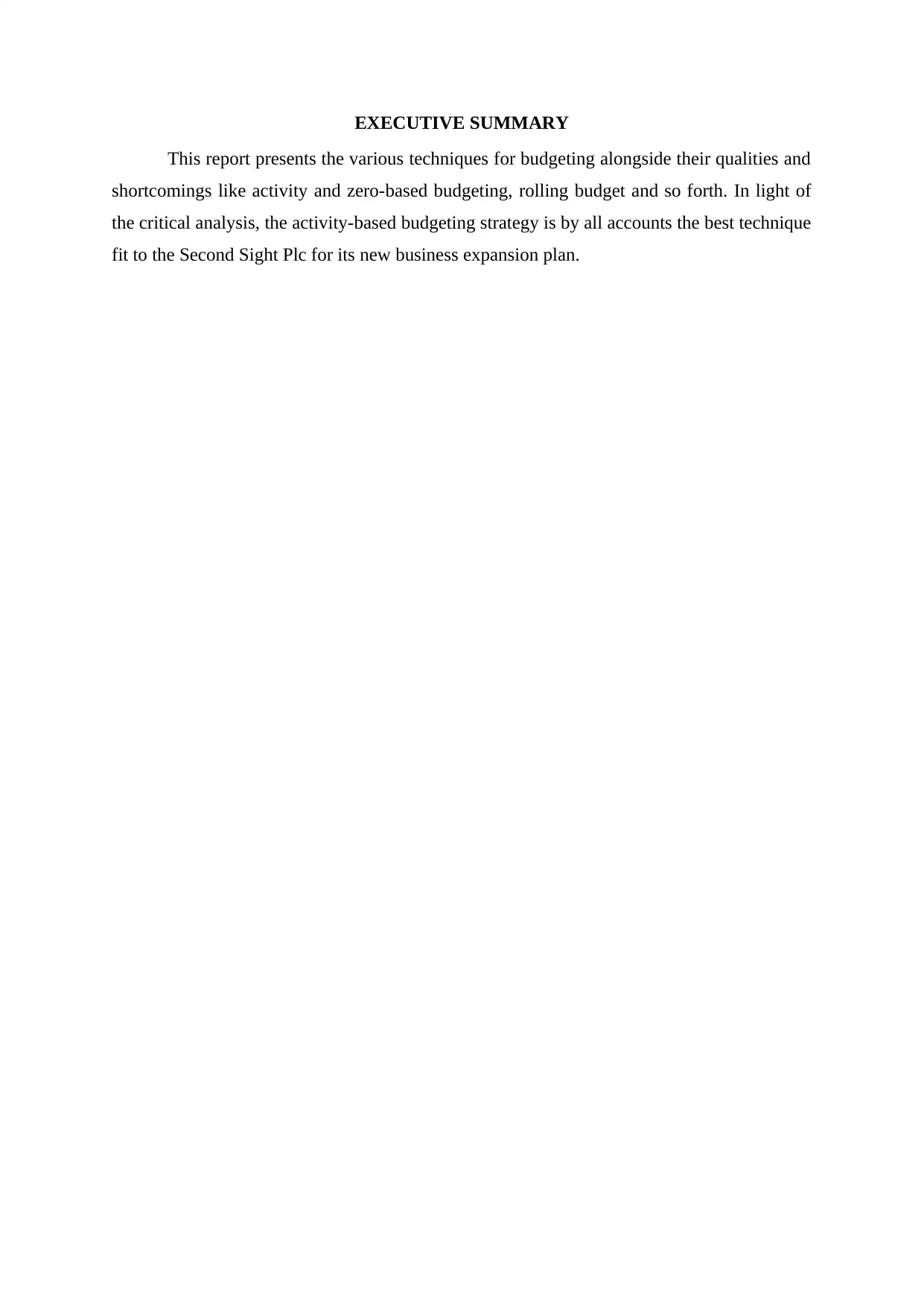
EXECUTIVE SUMMARY
This report presents the various techniques for budgeting alongside their qualities and
shortcomings like activity and zero-based budgeting, rolling budget and so forth. In light of
the critical analysis, the activity-based budgeting strategy is by all accounts the best technique
fit to the Second Sight Plc for its new business expansion plan.
This report presents the various techniques for budgeting alongside their qualities and
shortcomings like activity and zero-based budgeting, rolling budget and so forth. In light of
the critical analysis, the activity-based budgeting strategy is by all accounts the best technique
fit to the Second Sight Plc for its new business expansion plan.
Paraphrase This Document
Need a fresh take? Get an instant paraphrase of this document with our AI Paraphraser
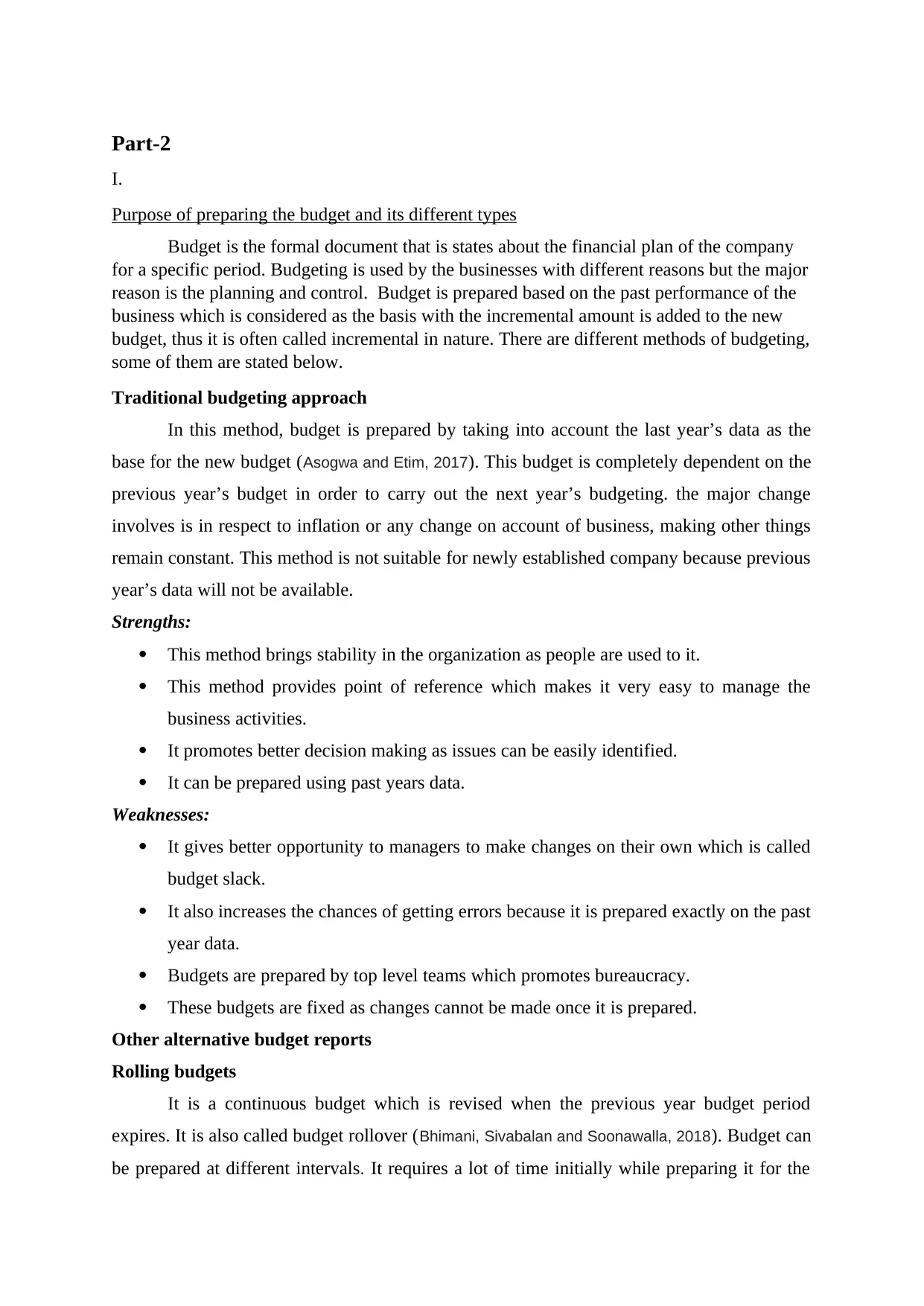
Part-2
I.
Purpose of preparing the budget and its different types
Budget is the formal document that is states about the financial plan of the company
for a specific period. Budgeting is used by the businesses with different reasons but the major
reason is the planning and control. Budget is prepared based on the past performance of the
business which is considered as the basis with the incremental amount is added to the new
budget, thus it is often called incremental in nature. There are different methods of budgeting,
some of them are stated below.
Traditional budgeting approach
In this method, budget is prepared by taking into account the last year’s data as the
base for the new budget (Asogwa and Etim, 2017). This budget is completely dependent on the
previous year’s budget in order to carry out the next year’s budgeting. the major change
involves is in respect to inflation or any change on account of business, making other things
remain constant. This method is not suitable for newly established company because previous
year’s data will not be available.
Strengths:
This method brings stability in the organization as people are used to it.
This method provides point of reference which makes it very easy to manage the
business activities.
It promotes better decision making as issues can be easily identified.
It can be prepared using past years data.
Weaknesses:
It gives better opportunity to managers to make changes on their own which is called
budget slack.
It also increases the chances of getting errors because it is prepared exactly on the past
year data.
Budgets are prepared by top level teams which promotes bureaucracy.
These budgets are fixed as changes cannot be made once it is prepared.
Other alternative budget reports
Rolling budgets
It is a continuous budget which is revised when the previous year budget period
expires. It is also called budget rollover (Bhimani, Sivabalan and Soonawalla, 2018). Budget can
be prepared at different intervals. It requires a lot of time initially while preparing it for the
I.
Purpose of preparing the budget and its different types
Budget is the formal document that is states about the financial plan of the company
for a specific period. Budgeting is used by the businesses with different reasons but the major
reason is the planning and control. Budget is prepared based on the past performance of the
business which is considered as the basis with the incremental amount is added to the new
budget, thus it is often called incremental in nature. There are different methods of budgeting,
some of them are stated below.
Traditional budgeting approach
In this method, budget is prepared by taking into account the last year’s data as the
base for the new budget (Asogwa and Etim, 2017). This budget is completely dependent on the
previous year’s budget in order to carry out the next year’s budgeting. the major change
involves is in respect to inflation or any change on account of business, making other things
remain constant. This method is not suitable for newly established company because previous
year’s data will not be available.
Strengths:
This method brings stability in the organization as people are used to it.
This method provides point of reference which makes it very easy to manage the
business activities.
It promotes better decision making as issues can be easily identified.
It can be prepared using past years data.
Weaknesses:
It gives better opportunity to managers to make changes on their own which is called
budget slack.
It also increases the chances of getting errors because it is prepared exactly on the past
year data.
Budgets are prepared by top level teams which promotes bureaucracy.
These budgets are fixed as changes cannot be made once it is prepared.
Other alternative budget reports
Rolling budgets
It is a continuous budget which is revised when the previous year budget period
expires. It is also called budget rollover (Bhimani, Sivabalan and Soonawalla, 2018). Budget can
be prepared at different intervals. It requires a lot of time initially while preparing it for the
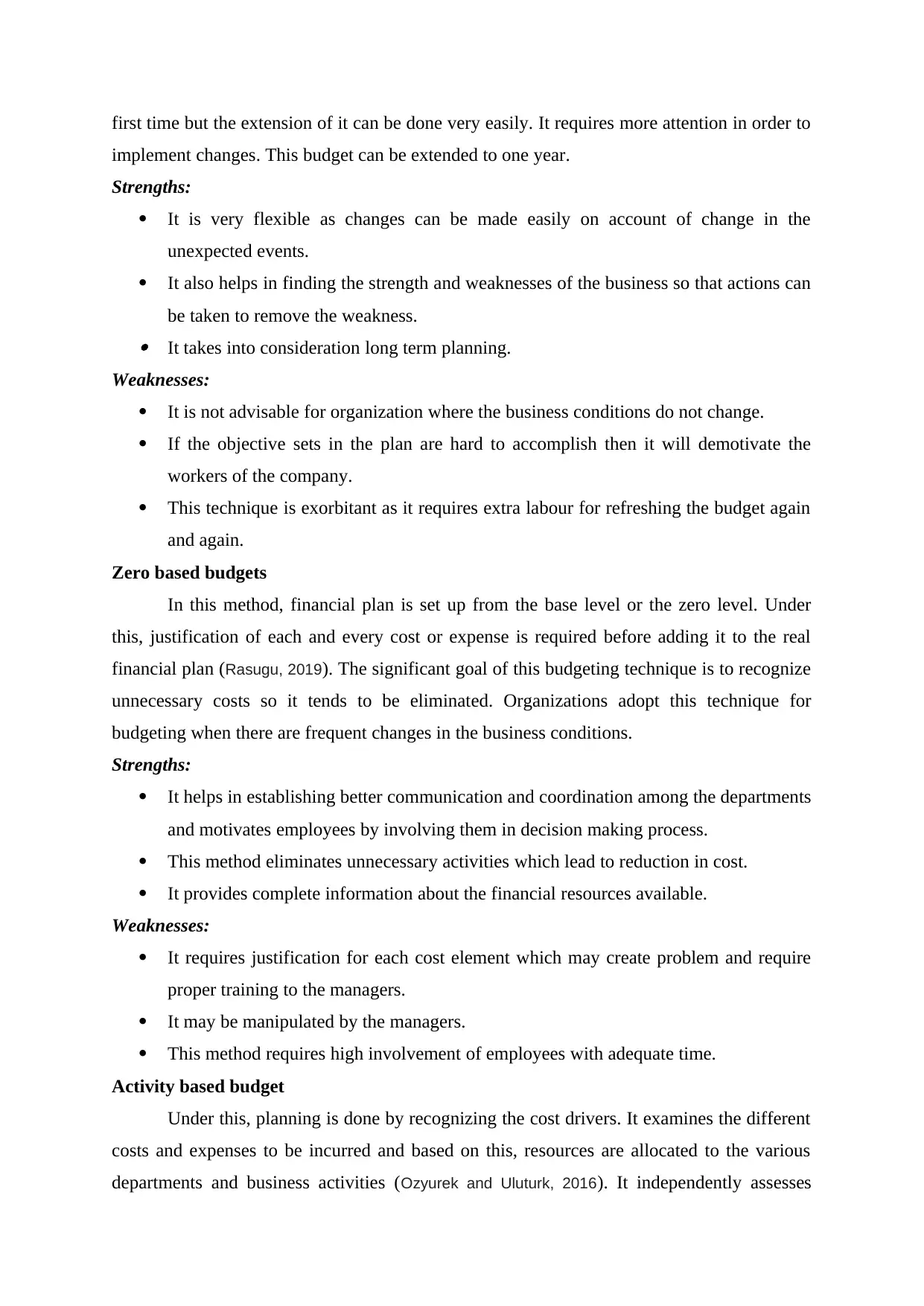
first time but the extension of it can be done very easily. It requires more attention in order to
implement changes. This budget can be extended to one year.
Strengths:
It is very flexible as changes can be made easily on account of change in the
unexpected events.
It also helps in finding the strength and weaknesses of the business so that actions can
be taken to remove the weakness. It takes into consideration long term planning.
Weaknesses:
It is not advisable for organization where the business conditions do not change.
If the objective sets in the plan are hard to accomplish then it will demotivate the
workers of the company.
This technique is exorbitant as it requires extra labour for refreshing the budget again
and again.
Zero based budgets
In this method, financial plan is set up from the base level or the zero level. Under
this, justification of each and every cost or expense is required before adding it to the real
financial plan (Rasugu, 2019). The significant goal of this budgeting technique is to recognize
unnecessary costs so it tends to be eliminated. Organizations adopt this technique for
budgeting when there are frequent changes in the business conditions.
Strengths:
It helps in establishing better communication and coordination among the departments
and motivates employees by involving them in decision making process.
This method eliminates unnecessary activities which lead to reduction in cost.
It provides complete information about the financial resources available.
Weaknesses:
It requires justification for each cost element which may create problem and require
proper training to the managers.
It may be manipulated by the managers.
This method requires high involvement of employees with adequate time.
Activity based budget
Under this, planning is done by recognizing the cost drivers. It examines the different
costs and expenses to be incurred and based on this, resources are allocated to the various
departments and business activities (Ozyurek and Uluturk, 2016). It independently assesses
implement changes. This budget can be extended to one year.
Strengths:
It is very flexible as changes can be made easily on account of change in the
unexpected events.
It also helps in finding the strength and weaknesses of the business so that actions can
be taken to remove the weakness. It takes into consideration long term planning.
Weaknesses:
It is not advisable for organization where the business conditions do not change.
If the objective sets in the plan are hard to accomplish then it will demotivate the
workers of the company.
This technique is exorbitant as it requires extra labour for refreshing the budget again
and again.
Zero based budgets
In this method, financial plan is set up from the base level or the zero level. Under
this, justification of each and every cost or expense is required before adding it to the real
financial plan (Rasugu, 2019). The significant goal of this budgeting technique is to recognize
unnecessary costs so it tends to be eliminated. Organizations adopt this technique for
budgeting when there are frequent changes in the business conditions.
Strengths:
It helps in establishing better communication and coordination among the departments
and motivates employees by involving them in decision making process.
This method eliminates unnecessary activities which lead to reduction in cost.
It provides complete information about the financial resources available.
Weaknesses:
It requires justification for each cost element which may create problem and require
proper training to the managers.
It may be manipulated by the managers.
This method requires high involvement of employees with adequate time.
Activity based budget
Under this, planning is done by recognizing the cost drivers. It examines the different
costs and expenses to be incurred and based on this, resources are allocated to the various
departments and business activities (Ozyurek and Uluturk, 2016). It independently assesses
⊘ This is a preview!⊘
Do you want full access?
Subscribe today to unlock all pages.

Trusted by 1+ million students worldwide
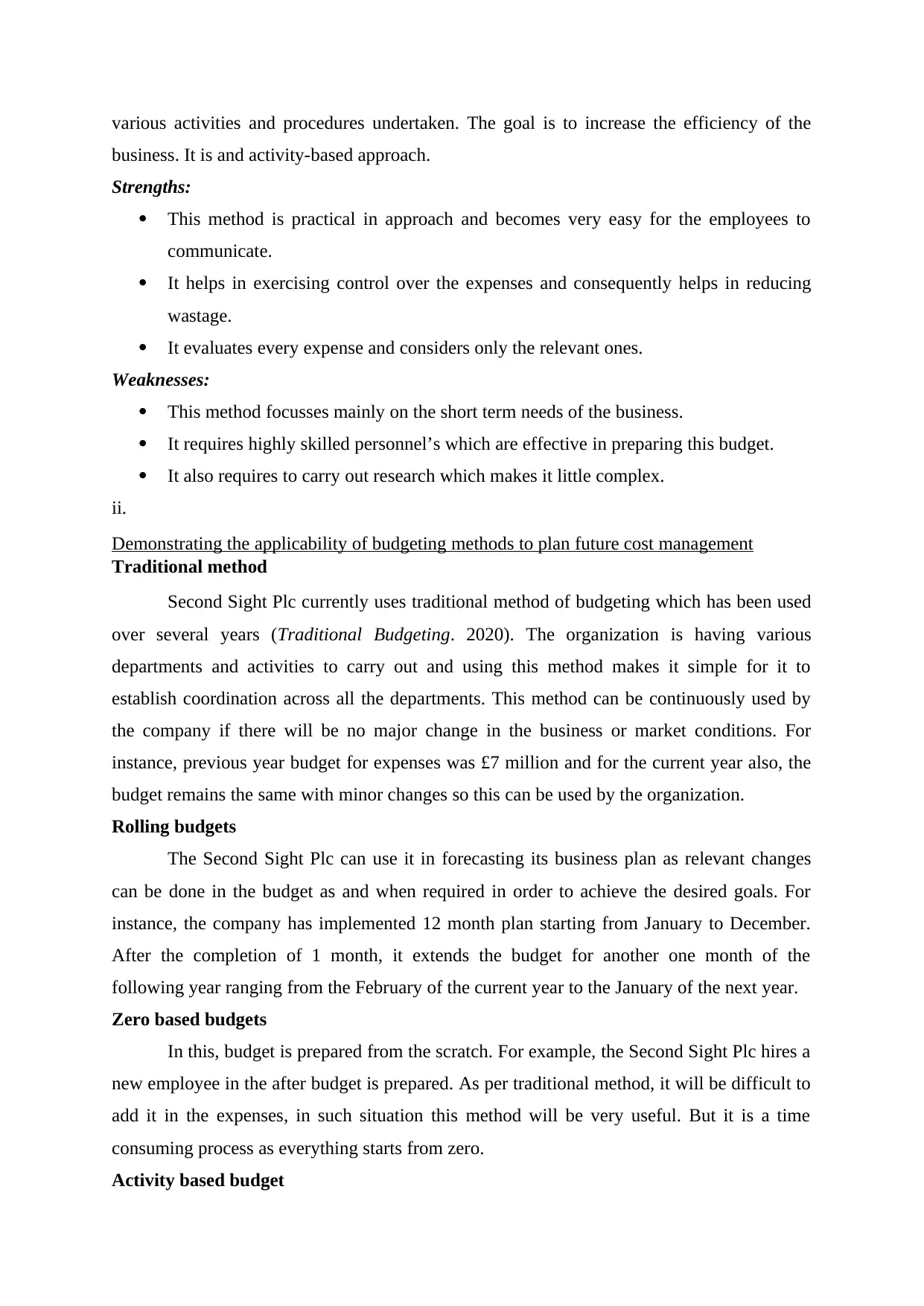
various activities and procedures undertaken. The goal is to increase the efficiency of the
business. It is and activity-based approach.
Strengths:
This method is practical in approach and becomes very easy for the employees to
communicate.
It helps in exercising control over the expenses and consequently helps in reducing
wastage.
It evaluates every expense and considers only the relevant ones.
Weaknesses:
This method focusses mainly on the short term needs of the business.
It requires highly skilled personnel’s which are effective in preparing this budget.
It also requires to carry out research which makes it little complex.
ii.
Demonstrating the applicability of budgeting methods to plan future cost management
Traditional method
Second Sight Plc currently uses traditional method of budgeting which has been used
over several years (Traditional Budgeting. 2020). The organization is having various
departments and activities to carry out and using this method makes it simple for it to
establish coordination across all the departments. This method can be continuously used by
the company if there will be no major change in the business or market conditions. For
instance, previous year budget for expenses was £7 million and for the current year also, the
budget remains the same with minor changes so this can be used by the organization.
Rolling budgets
The Second Sight Plc can use it in forecasting its business plan as relevant changes
can be done in the budget as and when required in order to achieve the desired goals. For
instance, the company has implemented 12 month plan starting from January to December.
After the completion of 1 month, it extends the budget for another one month of the
following year ranging from the February of the current year to the January of the next year.
Zero based budgets
In this, budget is prepared from the scratch. For example, the Second Sight Plc hires a
new employee in the after budget is prepared. As per traditional method, it will be difficult to
add it in the expenses, in such situation this method will be very useful. But it is a time
consuming process as everything starts from zero.
Activity based budget
business. It is and activity-based approach.
Strengths:
This method is practical in approach and becomes very easy for the employees to
communicate.
It helps in exercising control over the expenses and consequently helps in reducing
wastage.
It evaluates every expense and considers only the relevant ones.
Weaknesses:
This method focusses mainly on the short term needs of the business.
It requires highly skilled personnel’s which are effective in preparing this budget.
It also requires to carry out research which makes it little complex.
ii.
Demonstrating the applicability of budgeting methods to plan future cost management
Traditional method
Second Sight Plc currently uses traditional method of budgeting which has been used
over several years (Traditional Budgeting. 2020). The organization is having various
departments and activities to carry out and using this method makes it simple for it to
establish coordination across all the departments. This method can be continuously used by
the company if there will be no major change in the business or market conditions. For
instance, previous year budget for expenses was £7 million and for the current year also, the
budget remains the same with minor changes so this can be used by the organization.
Rolling budgets
The Second Sight Plc can use it in forecasting its business plan as relevant changes
can be done in the budget as and when required in order to achieve the desired goals. For
instance, the company has implemented 12 month plan starting from January to December.
After the completion of 1 month, it extends the budget for another one month of the
following year ranging from the February of the current year to the January of the next year.
Zero based budgets
In this, budget is prepared from the scratch. For example, the Second Sight Plc hires a
new employee in the after budget is prepared. As per traditional method, it will be difficult to
add it in the expenses, in such situation this method will be very useful. But it is a time
consuming process as everything starts from zero.
Activity based budget
Paraphrase This Document
Need a fresh take? Get an instant paraphrase of this document with our AI Paraphraser
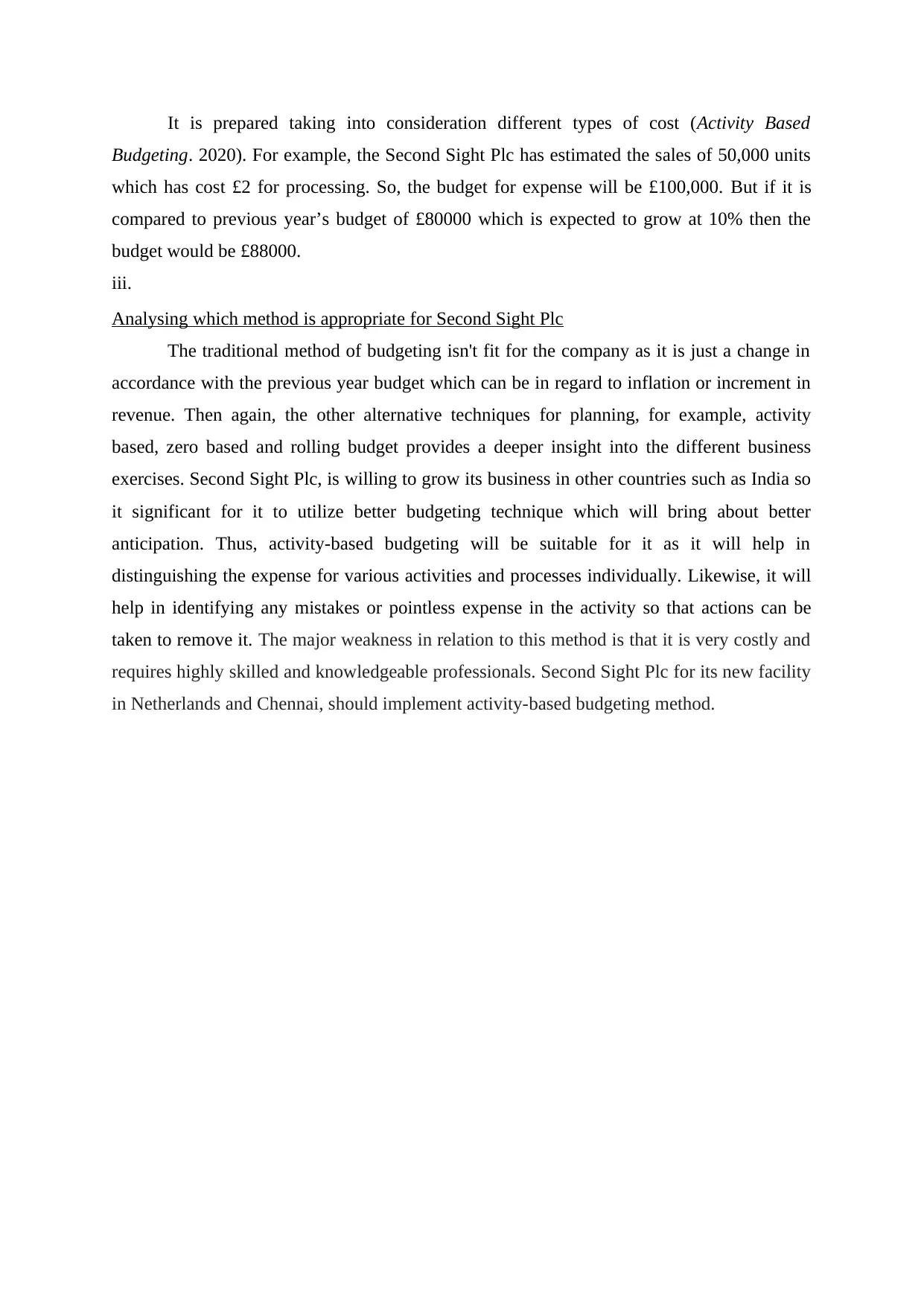
It is prepared taking into consideration different types of cost (Activity Based
Budgeting. 2020). For example, the Second Sight Plc has estimated the sales of 50,000 units
which has cost £2 for processing. So, the budget for expense will be £100,000. But if it is
compared to previous year’s budget of £80000 which is expected to grow at 10% then the
budget would be £88000.
iii.
Analysing which method is appropriate for Second Sight Plc
The traditional method of budgeting isn't fit for the company as it is just a change in
accordance with the previous year budget which can be in regard to inflation or increment in
revenue. Then again, the other alternative techniques for planning, for example, activity
based, zero based and rolling budget provides a deeper insight into the different business
exercises. Second Sight Plc, is willing to grow its business in other countries such as India so
it significant for it to utilize better budgeting technique which will bring about better
anticipation. Thus, activity-based budgeting will be suitable for it as it will help in
distinguishing the expense for various activities and processes individually. Likewise, it will
help in identifying any mistakes or pointless expense in the activity so that actions can be
taken to remove it. The major weakness in relation to this method is that it is very costly and
requires highly skilled and knowledgeable professionals. Second Sight Plc for its new facility
in Netherlands and Chennai, should implement activity-based budgeting method.
Budgeting. 2020). For example, the Second Sight Plc has estimated the sales of 50,000 units
which has cost £2 for processing. So, the budget for expense will be £100,000. But if it is
compared to previous year’s budget of £80000 which is expected to grow at 10% then the
budget would be £88000.
iii.
Analysing which method is appropriate for Second Sight Plc
The traditional method of budgeting isn't fit for the company as it is just a change in
accordance with the previous year budget which can be in regard to inflation or increment in
revenue. Then again, the other alternative techniques for planning, for example, activity
based, zero based and rolling budget provides a deeper insight into the different business
exercises. Second Sight Plc, is willing to grow its business in other countries such as India so
it significant for it to utilize better budgeting technique which will bring about better
anticipation. Thus, activity-based budgeting will be suitable for it as it will help in
distinguishing the expense for various activities and processes individually. Likewise, it will
help in identifying any mistakes or pointless expense in the activity so that actions can be
taken to remove it. The major weakness in relation to this method is that it is very costly and
requires highly skilled and knowledgeable professionals. Second Sight Plc for its new facility
in Netherlands and Chennai, should implement activity-based budgeting method.
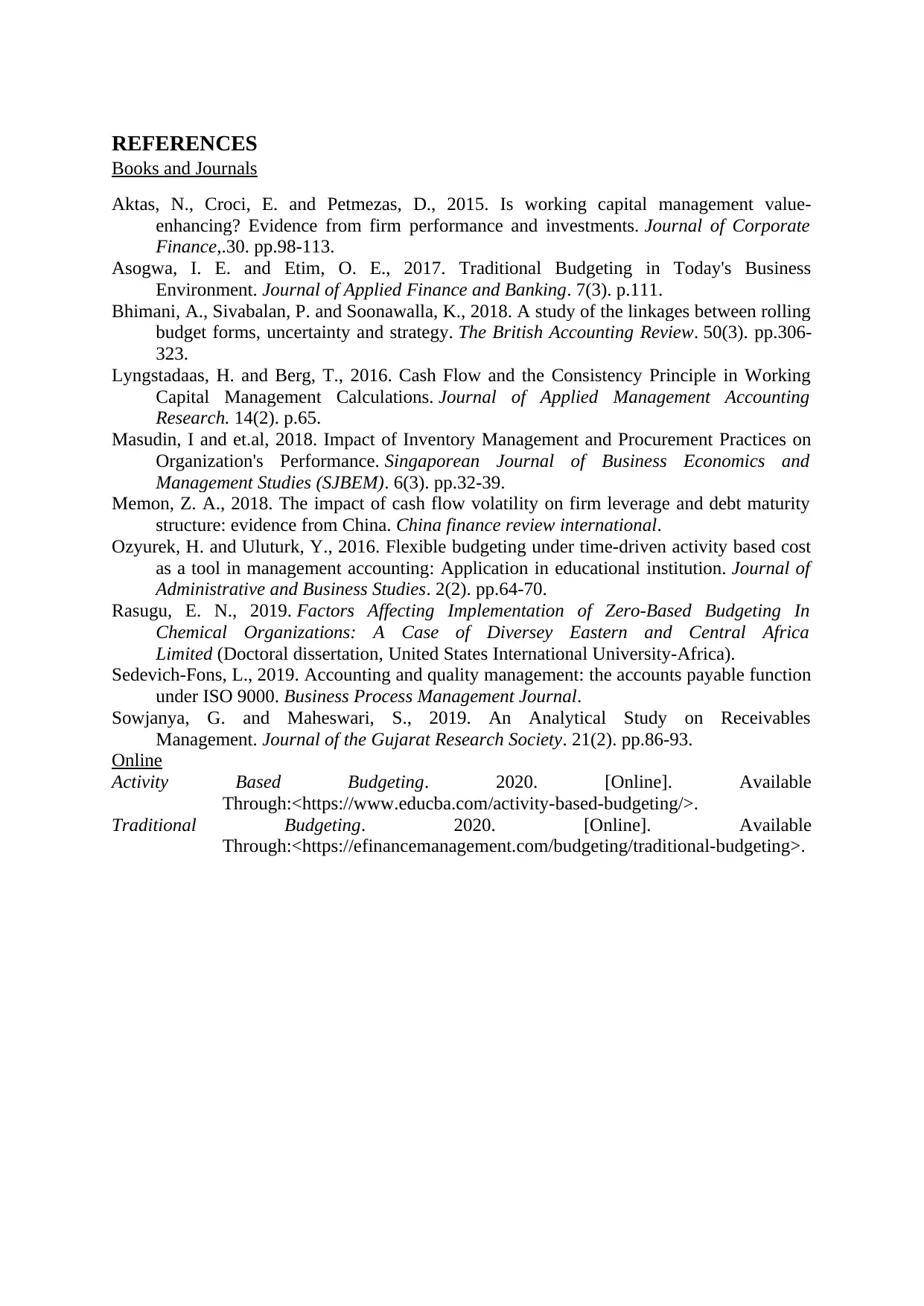
REFERENCES
Books and Journals
Aktas, N., Croci, E. and Petmezas, D., 2015. Is working capital management value-
enhancing? Evidence from firm performance and investments. Journal of Corporate
Finance,.30. pp.98-113.
Asogwa, I. E. and Etim, O. E., 2017. Traditional Budgeting in Today's Business
Environment. Journal of Applied Finance and Banking. 7(3). p.111.
Bhimani, A., Sivabalan, P. and Soonawalla, K., 2018. A study of the linkages between rolling
budget forms, uncertainty and strategy. The British Accounting Review. 50(3). pp.306-
323.
Lyngstadaas, H. and Berg, T., 2016. Cash Flow and the Consistency Principle in Working
Capital Management Calculations. Journal of Applied Management Accounting
Research. 14(2). p.65.
Masudin, I and et.al, 2018. Impact of Inventory Management and Procurement Practices on
Organization's Performance. Singaporean Journal of Business Economics and
Management Studies (SJBEM). 6(3). pp.32-39.
Memon, Z. A., 2018. The impact of cash flow volatility on firm leverage and debt maturity
structure: evidence from China. China finance review international.
Ozyurek, H. and Uluturk, Y., 2016. Flexible budgeting under time-driven activity based cost
as a tool in management accounting: Application in educational institution. Journal of
Administrative and Business Studies. 2(2). pp.64-70.
Rasugu, E. N., 2019. Factors Affecting Implementation of Zero-Based Budgeting In
Chemical Organizations: A Case of Diversey Eastern and Central Africa
Limited (Doctoral dissertation, United States International University-Africa).
Sedevich-Fons, L., 2019. Accounting and quality management: the accounts payable function
under ISO 9000. Business Process Management Journal.
Sowjanya, G. and Maheswari, S., 2019. An Analytical Study on Receivables
Management. Journal of the Gujarat Research Society. 21(2). pp.86-93.
Online
Activity Based Budgeting. 2020. [Online]. Available
Through:<https://www.educba.com/activity-based-budgeting/>.
Traditional Budgeting. 2020. [Online]. Available
Through:<https://efinancemanagement.com/budgeting/traditional-budgeting>.
Books and Journals
Aktas, N., Croci, E. and Petmezas, D., 2015. Is working capital management value-
enhancing? Evidence from firm performance and investments. Journal of Corporate
Finance,.30. pp.98-113.
Asogwa, I. E. and Etim, O. E., 2017. Traditional Budgeting in Today's Business
Environment. Journal of Applied Finance and Banking. 7(3). p.111.
Bhimani, A., Sivabalan, P. and Soonawalla, K., 2018. A study of the linkages between rolling
budget forms, uncertainty and strategy. The British Accounting Review. 50(3). pp.306-
323.
Lyngstadaas, H. and Berg, T., 2016. Cash Flow and the Consistency Principle in Working
Capital Management Calculations. Journal of Applied Management Accounting
Research. 14(2). p.65.
Masudin, I and et.al, 2018. Impact of Inventory Management and Procurement Practices on
Organization's Performance. Singaporean Journal of Business Economics and
Management Studies (SJBEM). 6(3). pp.32-39.
Memon, Z. A., 2018. The impact of cash flow volatility on firm leverage and debt maturity
structure: evidence from China. China finance review international.
Ozyurek, H. and Uluturk, Y., 2016. Flexible budgeting under time-driven activity based cost
as a tool in management accounting: Application in educational institution. Journal of
Administrative and Business Studies. 2(2). pp.64-70.
Rasugu, E. N., 2019. Factors Affecting Implementation of Zero-Based Budgeting In
Chemical Organizations: A Case of Diversey Eastern and Central Africa
Limited (Doctoral dissertation, United States International University-Africa).
Sedevich-Fons, L., 2019. Accounting and quality management: the accounts payable function
under ISO 9000. Business Process Management Journal.
Sowjanya, G. and Maheswari, S., 2019. An Analytical Study on Receivables
Management. Journal of the Gujarat Research Society. 21(2). pp.86-93.
Online
Activity Based Budgeting. 2020. [Online]. Available
Through:<https://www.educba.com/activity-based-budgeting/>.
Traditional Budgeting. 2020. [Online]. Available
Through:<https://efinancemanagement.com/budgeting/traditional-budgeting>.
⊘ This is a preview!⊘
Do you want full access?
Subscribe today to unlock all pages.

Trusted by 1+ million students worldwide
1 out of 13
Related Documents
Your All-in-One AI-Powered Toolkit for Academic Success.
+13062052269
info@desklib.com
Available 24*7 on WhatsApp / Email
![[object Object]](/_next/static/media/star-bottom.7253800d.svg)
Unlock your academic potential
Copyright © 2020–2025 A2Z Services. All Rights Reserved. Developed and managed by ZUCOL.





